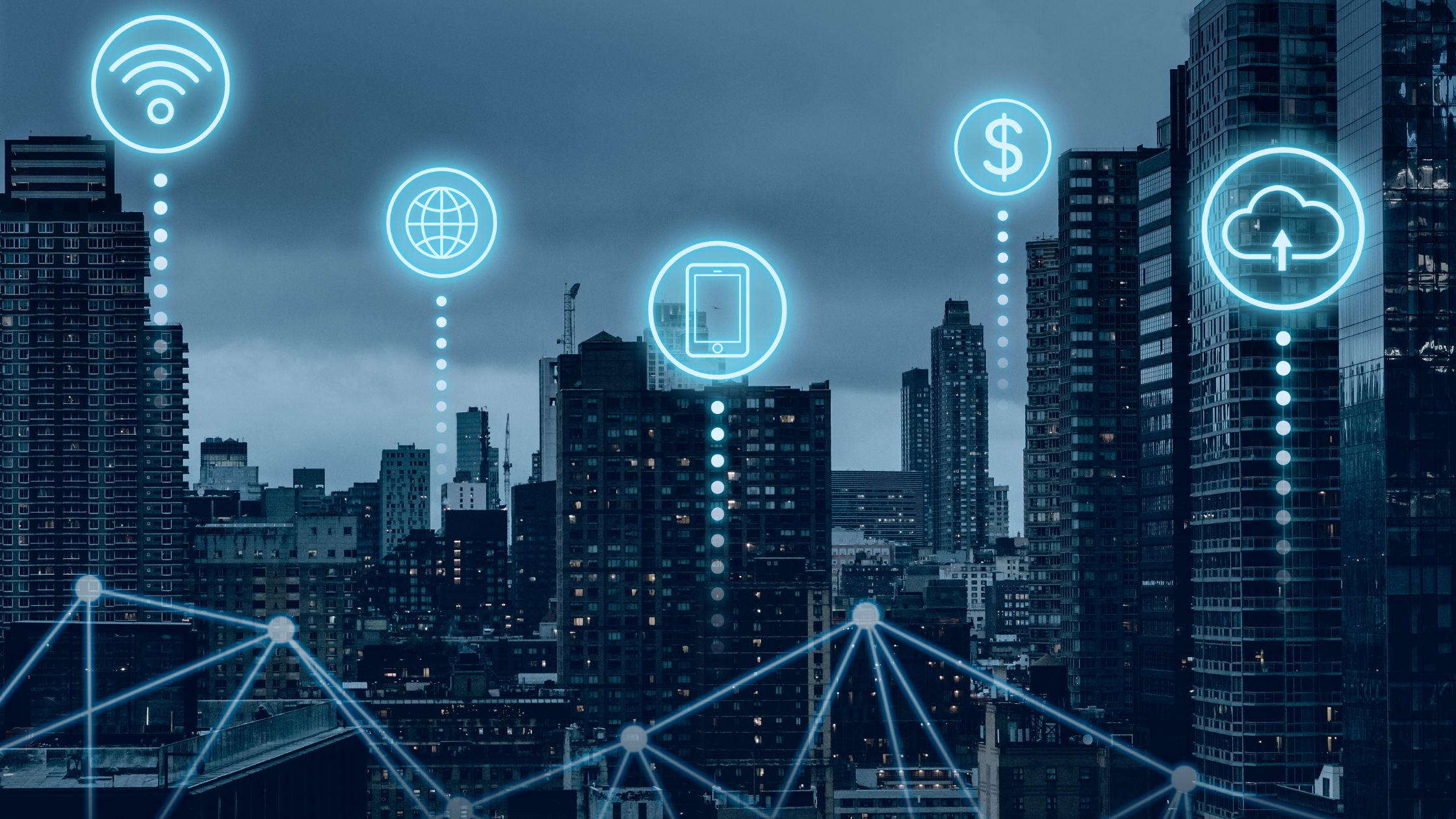If you’ve ever worked in an office, you’ve probably complained about the temperature at some point. Controlling the thermostat in large commercial buildings is tricky and is often a constant struggle.
That’s because different building sections are affected by sunlight and shade differently, making it challenging to maintain consistently comfortable temperatures. Even with an efficient and well-functioning HVAC system, it can be tough to achieve uniformity throughout.
Smart building technology is changing all this. It’s making manual heating and cooling controls obsolete—and on a bigger scale, it’s changing the future of commercial real estate.
How big is the market for smart buildings?
Did you know that the smart building market is growing so fast that experts expect it to grow at a CAGR of 12.3% and reach a market size of $247.17 billion by 2032? No wonder savvy CRE investors and building owners are investing in smart systems.
The demand for comprehensive IoT suites that deliver crucial metrics instantly is particularly strong, as this is the type of technology that allows tenants and building managers to optimize resources as well as balance comfort and costs.
More and more CRE building owners are using data to provide tenants with tailored services such as personalized energy reports and space utilization insights that can be used to formulate comfort optimization solutions.
Beyond temperature, CRE investors are also starting to integrate IoT-based services like security monitoring into their properties to turn them into smart buildings.
What exactly is a smart building?
A smart building is one that uses technology to automate the management of certain building operations like temperature, lighting, and security.
Here’s how it works: Sensors designed to detect changes (such as temperature fluctuations and lighting levels) are installed throughout the building.
These sensors then relay this data to the management software, which then automatically adjusts targeted adjustments only in the areas needed, adapting over time to occupancy and seasonal changes.
If you’re a CRE investor, then you know that many sections in large buildings remain unused even during the day. Automated systems detect these vacant areas and turn off lights or the air conditioning/heating to conserve energy.
The result? Energy waste from heating or cooling unoccupied spaces is minimized. These systems can even be tailored to individual tenant preferences, potentially reducing disagreements over lighting and temperature conditions.
Smart technologies can also be used for security, particularly in access control. These systems can grant temporary entry to authorized personnel (via cards or phones) and even send real-time alerts to your security team when they detect suspicious activities.
You can even deploy sensors to monitor environmental conditions like water leaks and prevent costly damage.
As you can see, smart buildings are truly quite impressive. But did you know that building automation technology isn’t new?
It actually started over a decade ago. However, smart buildings primarily focused on HVAC and reducing operating costs back then.
Fast forward to today and advancements in sensor technology and IoT have made these systems even better, bringing even more sustainability and savings opportunities for CRE building owners.
What is the role of IoT in smart buildings?
You might not realize it, but you probably already use IoT in everyday life. It’s the same technology that integrates your mobile phone with your thermostat, sound system, or your smartwatch and other wearables.
So what is it, exactly? IoT or the Internet of Things is the term used to refer to a network of connected smart devices that operate as a cohesive system.
While smart devices can connect to larger networks, only those that actively exchange data and integrate into systems are considered part of the IoT ecosystem. These devices are equipped with sensors and software designed to collect and communicate data within a network of connected devices.
IoT’s potential goes way beyond streamlining operations and boosting a building’s efficiency. It is changing commercial real estate management as we know it with applications in security, lighting, HVAC, and even asset tracking.
What are the benefits of ‘going smart’ in commercial real estate?
Make your building more energy efficient.
IoT sensors that provide real-time data on occupancy and indoor environmental conditions can trigger automatic adjustments to lighting, HVAC, and other building systems. This can ultimately minimize your CRE building’s energy consumption and drive your operational costs down.
Improve your tenants’ experiences.
You can use IoT-enabled devices and systems for intelligent climate control and automated access systems to create a more comfortable and secure environment for your tenants. You can even allow them to choose settings that best suit their tasks or adjust their workspace conditions to their comfort levels.
Investing in smart lighting and responsive air purification can also elevate the comfort and satisfaction of your building’s occupants. More than that, it can make your building healthier for everyone.
Did you know that some of the most luxurious office buildings now implement circadian lighting to mimic natural sunlight and use advanced systems to minimize air pollutants and manage CO2 levels?
Streamline your operations.
You can leverage automation and data analytics in smart buildings to monitor and control various systems remotely. which reduces labor and maintenance costs.
Optimize space utilization.
Because they provide insights into how spaces are utilized, smart building technologies help you optimize floor plans and enhance tenant satisfaction. You can also rely on this information for your future property development projects.
Prevent expensive breakdowns with predictive maintenance.
Smart systems for commercial buildings integrate predictive analytics and machine learning algorithms to detect potential maintenance issues before they cause a lot of damage. By being proactive, you can extend the lifespan of your building systems and cut costs.
Increased your CRE property’s
Smart technologies can improve your building’s functionality and appeal, therefore increasing its market value—or at least giving you a competitive edge in a cut-throat tenant’s market. They turn your property into a highly efficient, occupant-friendly, and economically viable space that tenants will want to lease for the long term.
Help turn your city into a smart city.
Is your city or municipality starting to deploy IoT solutions and connected technologies to improve public safety and critical infrastructure? Then you need to do your part in making it a better place to work, live, and play—characteristics that will ultimately improve the local property market and boost your commercial building’s value.
After all, smart cities begin with smart buildings. Did you know that buildings account for about 30% of the world’s energy use?
Enhancing energy management in these buildings is absolutely essential if we want to reduce global energy consumption.
And as a CRE owner, you can contribute to energy conservation and financial savings across the globe. Modernizing your HVAC systems to respond dynamically to time, temperature, and environmental changes is just the starting point.
What are the challenges of implementing smart building technologies?
- Smart building technologies require significant upfront investments. This is especially true if your building is older, as you will probably need to do some extensive retrofitting. Assess the long-term benefits against these initial expenditures to determine if such upgrades make sense. It’s also a good idea to compare different financing solutions to get the best deals (if you need a loan to turn your property into a smart building).
- Integrating various smart systems—such as HVAC, lighting, security, and data analytics—and making sure that they communicate seamlessly is a complex process, to say the least. You will need to bring in IoT and smart building experts to harness the full potential of these technologies. The ongoing tech talent shortage makes it harder to find professionals equipped with these specialized skills, posing a challenge for ongoing operations and maintenance.
- With greater connectivity comes increased vulnerability to cyberattacks. Smart buildings that rely on interconnected devices are potential targets for hackers. Be sure to have cybersecurity measures in place to protect your own sensitive data and ensure your occupants’ privacy and safety. You also need to find a balance between capturing insights and respecting tenant privacy.
- Interoperability issues may arise when different technologies from various vendors do not integrate seamlessly. While standardization efforts are making progress, a fully unified system across all CRE tech may still be a way off.
There’s no doubt that smart technology can transform how commercial real estate properties—particularly office buildings—are managed and operated.
By automating indoor environmental quality factors such as temperature, humidity, lighting, and air quality, IoT systems can enhance the comfort of your tenants while reducing your operating costs.
Going smart can also give you knew revenue opportunities as a CRE investor or building owner. When you upgrade your building with smart technologies, you can attract long-term anchor tenants—large and well-established businesses that place a high value on technology and efficiency.
If you need financing to upgrade your current CRE property into a smart building, contact our team here at Private Capital Investors.





